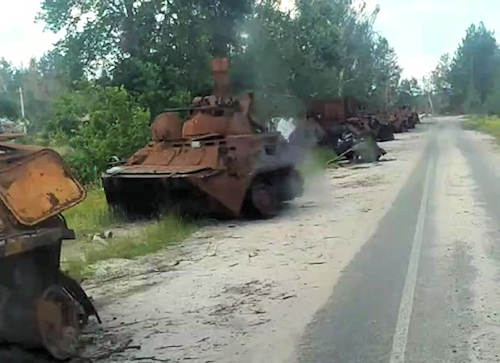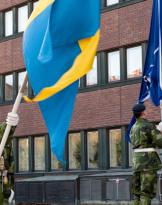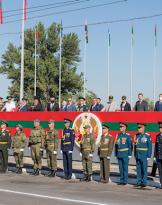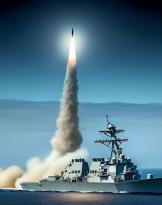Take a good look at the map and the photos at the bottom of the article: the first shows what happened in the last three weeks in the locations indicated on the map of Ukraine.
The counter-offensive of the Kiev forces has not yet begun but something has already happened that has put an end to the second phase as we have seen it since the beginning of the "great counter-offensive" (see article) in the first half of April, which actually changed the rules of war as we were used to seeing it since February 24th.
But let's go in order ...
At the end of March, after a month of inadequate pressure on the longest war front in European history, from the north of Kiev to the Island of the Serpents in the Odessa oblast, the Kremlin gave the order to withdraw from the oblast of Chernihiv, Sumy and of Kiev itself, in practice a territory as large as Northern Italy (see article).
A simple still image like this one in the photo below makes us understand what happened.
What have Russian leaders done in the northern region of Ukraine that led to these losses?

They allowed the Ukrainian defenders, unexpectedly - for the Russians - able to resist like lions, to annihilate special forces, Chechen militiamen and tanks in absurd quantities. Helicopters and planes full of troops destined by the Kremlin to take Kiev but remained inactive, while the tankers sent to the vanguard were torn to pieces, they say a lot: it was necessary to redesign everything to avoid political and military failure.
This leads to the capture of Izium, the main town on the eastern flank of the Kharkiv oblast, and on April 12 the start of the so-called "great offensive", the aim of which was to take the entire Donbass.
Once again, the Ukrainians surprised Moscow by adopting, so to speak, the approach of General Kutuzov, the winner of Napoleon, rather than that of Stalin, first a friend and then a victim of Hitler: in short, they preferred to save the army at cost. to lose ground thus maintaining the possibility of saving the country, rather than being tempted not to take a single step back.
The Kiev troops took several steps backwards, but in the end they forced the Russian forces to gain a few kilometers in the Luhansk oblast - the area around Severodonetsk and Lysichansk measures half the province of Lodi, while the whole Ukraine has twice the area of Italy - at the cost of enormous human and material losses.
 Above all, they learned a great deal from the test of strength set up by the Russians with the massive use of artillery: rockets, bombs and missiles made up for Moscow's chronic deficiencies in the quality of vehicles and logistics, as well as in training and morale. of the staff. But they also exposed the soft underbelly of Russian power: the artillery has a bulimic hunger for ammunition and fuel, without which it simply has to slow to a halt. And here comes the game changer...
Above all, they learned a great deal from the test of strength set up by the Russians with the massive use of artillery: rockets, bombs and missiles made up for Moscow's chronic deficiencies in the quality of vehicles and logistics, as well as in training and morale. of the staff. But they also exposed the soft underbelly of Russian power: the artillery has a bulimic hunger for ammunition and fuel, without which it simply has to slow to a halt. And here comes the game changer...
The M142 HIMARS (High Mobility Artillery Rocket System - previous photo), multiple and light rocket launchers developed in the late 90s for the United States Army, mounted on a standard US Army M1140 truck chassis.
 It is not for me to talk about it and I will not: I will limit myself to saying that being able to hit Russian depots and bases easily, quickly and safely, the Ukrainians have done in a few weeks what you see in the photo at the beginning of the article ... they have, pass me the term, emptied the warehouses that the Russian occupiers had set up all over the Donbass, coming to strike day and night in and around Donetsk.
It is not for me to talk about it and I will not: I will limit myself to saying that being able to hit Russian depots and bases easily, quickly and safely, the Ukrainians have done in a few weeks what you see in the photo at the beginning of the article ... they have, pass me the term, emptied the warehouses that the Russian occupiers had set up all over the Donbass, coming to strike day and night in and around Donetsk.
All this has caused a collapse in the capacity of Russian artillery: it is these days the announcement by the military governor of Luhansk Serhei Haidar that the Ukrainians are experiencing a drastic decline in Russian firepower across the eastern front. Caution: I am not saying that the Russian artillery is at a standstill but that now the commanders must take into account the escorts on the front line, because almost nothing can come from behind.
As if that were not enough, the same "warehouse cleaning" operation is also taking place in southern Ukraine, where the HIMARS and other modern weapon systems in the hands of the Ukrainians (trained by the thousands by the US and allies) have done massacres in command centers, hit air bases, damaged or interrupted connecting routes of strategic importance for the Russian occupiers.
 The image opposite is from Kherson.
The image opposite is from Kherson.
Now, new rockets capable of hitting up to approximately 300 kilometers in depth are expected, the target of which will no longer be just barracks and warehouses, but the road links between southern Ukraine and the Crimea occupied by Moscow in 2014.
In an interview with The Times, the former commander of NATO forces, the American general Philip Breedlove, defined the Kerch bridge, the one that connects Crimea to mainland Russia a legitimate target. The fact that Kiev has waved the technical data and the exercises of the Russian forces on the management of an attack suggest that on both sides it is believed that Breedlove has only anticipated the near future. We also consider that with the anti-ship missile systems in use in Kiev and the bridge rendered inoperable, Crimea would be at serious risk…
So, here we are in the "third phase"
A few weeks from now, it will be in Moscow again to give the cards to react to this leap forward by the Ukrainians. For now, the war has taught us that what everyone called impossible and crazy yesterday, tomorrow will be the new rule: so it was for the supply of anti-tank weapons, for those of ex-Soviet tanks and planes, for the shipment of weapons. and the training of Ukrainian soldiers, for the supply of howitzers and HIMARS, for the dispatch of medium-range rockets, etc.
What will be the next taboo to become the norm?
Photo: web / US Army National Guard












